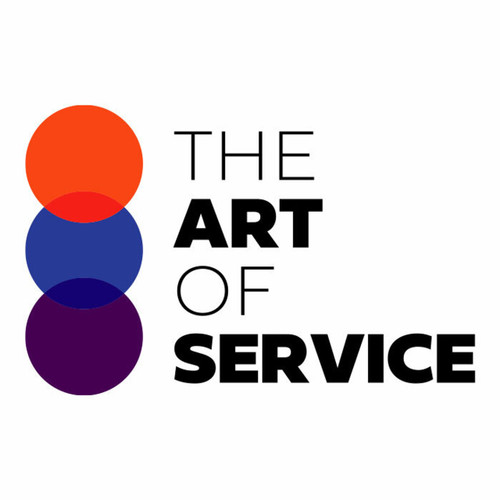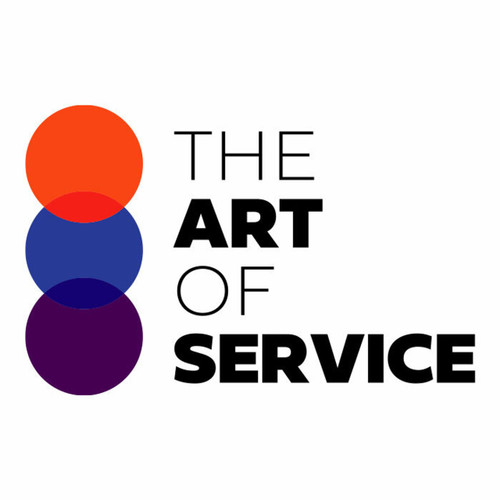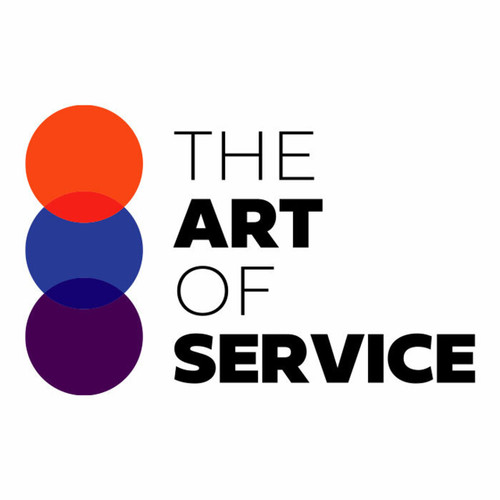Our dataset consists of 1502 carefully selected and prioritized requirements, solutions, benefits, results, and real-life case studies/examples for both data classification and data obsolescence.
This wealth of information is all you need to effectively manage and optimize your data processes.
Compared to other options in the market, our Data Classification and Data Obsolescence Knowledge Base stands out as the most comprehensive and user-friendly tool available.
It is specifically designed for professionals like you, who value accurate and up-to-date data management techniques.
Our product is a one-stop-shop, offering a wide range of solutions for both data classification and data obsolescence.
It is easy to navigate and provides step-by-step guidance on how to use the information to achieve the best results for your business.
But that′s not all.
Our Data Classification and Data Obsolescence Knowledge Base is not only effective, but it is also affordable.
Say goodbye to expensive consultants and complicated software - now you have a DIY alternative at your fingertips.
We understand the importance of data for businesses, which is why our product is backed by extensive research and industry expertise.
We have done the hard work for you, so you can focus on what′s important - growing your business.
Our Data Classification and Data Obsolescence Knowledge Base is suitable for all types of businesses, big or small.
No matter the size of your company, our dataset will help you identify and eliminate any potential data risks, saving you time and money in the long run.
Speaking of savings, our product is cost-efficient and offers more benefits than its alternatives.
With our Knowledge Base, you will have access to all the necessary information to effectively manage your data, without breaking the bank.
We believe in full transparency, which is why we want you to know the pros and cons of our product.
We pride ourselves on providing accurate, reliable, and unbiased information, so you can make informed decisions for your business.
In conclusion, our Data Classification and Data Obsolescence Knowledge Base is a game-changer for businesses looking to streamline their data processes.
It′s easy to use, affordable, and backed by extensive research - what more could you ask for? Don′t waste any more time, get your hands on our dataset today and see the results for yourself!
Discover Insights, Make Informed Decisions, and Stay Ahead of the Curve:
Key Features:
Comprehensive set of 1502 prioritized Data Classification requirements. - Extensive coverage of 110 Data Classification topic scopes.
- In-depth analysis of 110 Data Classification step-by-step solutions, benefits, BHAGs.
- Detailed examination of 110 Data Classification case studies and use cases.
- Digital download upon purchase.
- Enjoy lifetime document updates included with your purchase.
- Benefit from a fully editable and customizable Excel format.
- Trusted and utilized by over 10,000 organizations.
- Covering: Backup And Recovery Processes, Data Footprint, Data Architecture, Obsolete Technology, Data Retention Strategies, Data Backup Protocols, Migration Strategy, Data Obsolescence Costs, Legacy Data, Data Transformation, Data Integrity Checks, Data Replication, Data Transfer, Parts Obsolescence, Research Group, Risk Management, Obsolete File Formats, Obsolete Software, Storage Capacity, Data Classification, Total Productive Maintenance, Data Portability, Data Migration Challenges, Data Backup, Data Preservation Policies, Data Lifecycles, Data Archiving, Backup Storage, Data Migration, Legacy Systems, Cloud Storage, Hardware Failure, Data Modernization, Data Migration Risks, Obsolete Devices, Information Governance, Outdated Applications, External Processes, Software Obsolescence, Data Longevity, Data Protection Mechanisms, Data Retention Rules, Data Storage, Data Retention Tools, Data Recovery, Storage Media, Backup Frequency, Disaster Recovery, End Of Life Planning, Format Compatibility, Data Disposal, Data Access, Data Obsolescence Planning, Data Retention Standards, Open Data Standards, Obsolete Hardware, Data Quality, Product Obsolescence, Hardware Upgrades, Data Disposal Process, Data Ownership, Data Validation, Data Obsolescence, Predictive Modeling, Data Life Expectancy, Data Destruction Methods, Data Preservation Techniques, Data Lifecycle Management, Data Reliability, Data Migration Tools, Data Security, Data Obsolescence Monitoring, Data Redundancy, Version Control, Data Retention Policies, Data Backup Frequency, Backup Methods, Technology Advancement, Data Retention Regulations, Data Retrieval, Data Transformation Tools, Cloud Compatibility, End Of Life Data Management, Data Remediation, Data Obsolescence Management, Data Preservation, Data Management, Data Retention Period, Data Legislation, Data Compliance, Data Migration Cost, Data Storage Costs, Data Corruption, Digital Preservation, Data Retention, Data Obsolescence Risks, Data Integrity, Data Migration Best Practices, Collections Tools, Data Loss, Data Destruction, Cloud Migration, Data Retention Costs, Data Decay, Data Replacement, Data Migration Strategies, Preservation Technology, Long Term Data Storage, Software Migration, Software Updates
Data Classification Assessment Dataset - Utilization, Solutions, Advantages, BHAG (Big Hairy Audacious Goal):
Data Classification
Data classification refers to the categorization of data based on its level of sensitivity or confidentiality in order to determine appropriate security measures for its protection.
- Regularly review and update classification scheme for accurate identification of sensitive data.
- Implement controls to restrict access to classified data to authorized personnel.
- Train employees on data handling procedures and the importance of data classification.
- Utilize encryption and other security measures to protect classified data from unauthorized access.
- Develop a data retention policy to determine the lifespan of different types of data.
- Regularly purge or dispose of obsolete data in accordance with the data retention policy.
- Use data backup solutions to ensure important data is not lost due to storage media obsolescence.
- Implement data archiving systems to store and preserve important historical data.
- Establish a data governance framework to manage and monitor data classification processes.
- Conduct regular risk assessments to identify potential threats to classified data and implement appropriate controls.
CONTROL QUESTION: Has the organization developed or followed a data classification scheme?
Big Hairy Audacious Goal (BHAG) for 10 years from now:
In 10 years, my organization will be leading the industry in data classification practices, with a comprehensive and advanced system in place. Our data classification scheme will be not only highly effective in protecting sensitive information, but also adaptive and scalable to meet the ever-changing landscape of data privacy and security.
We will have developed and implemented cutting-edge technology and techniques for identifying and categorizing different types of data, including personal, financial, and intellectual property. Our system will be able to automatically flag and classify data based on its level of sensitivity and risk, reducing the need for manual classification.
Furthermore, our organization will have become a thought leader in data classification, regularly contributing research and insights to the field. We will have established partnerships with leading universities and organizations to continuously improve our classification scheme and stay ahead of emerging threats.
Our success in data classification will not only benefit our own organization, but also set a standard for others to follow. We hope to inspire and assist other companies in developing their own comprehensive data classification schemes, ultimately creating a safer and more secure digital world.
Customer Testimonials:
"Five stars for this dataset! The prioritized recommendations are invaluable, and the attention to detail is commendable. It has quickly become an essential tool in my toolkit."
"I`ve recommended this dataset to all my colleagues. The prioritized recommendations are top-notch, and the attention to detail is commendable. It has become a trusted resource in our decision-making process."
"This dataset sparked my creativity and led me to develop new and innovative product recommendations that my customers love. It`s opened up a whole new revenue stream for my business."
Data Classification Case Study/Use Case example - How to use:
Synopsis of Client Situation:
The client, a large multinational corporation in the technology sector, had identified the need to develop a data classification scheme for their organization. With increasing concerns around data breaches and compliance regulations, the client recognized the importance of classifying their data according to its sensitivity and impact on the organization. The lack of a defined data classification scheme had led to challenges in managing and protecting their data, resulting in potential risks to the organization′s reputation and financial stability.
Consulting Methodology:
To address the client′s concerns, our consulting firm proposed a comprehensive approach that included the following steps:
1. Assess current data management practices: Our team conducted interviews and workshops with key stakeholders to understand the organization′s current data management practices. This included identifying where data was stored, how it was accessed, and the existing security measures in place.
2. Identify data categories: Based on the findings from the assessment, we worked with the client to define the different categories of data based on its sensitivity and impact. This included personal data, financial data, intellectual property, etc.
3. Define classification criteria: We worked closely with the client to establish a set of criteria for classifying data into the identified categories. This involved considering factors such as confidentiality, availability, and integrity of the data.
4. Create a classification scheme: Using the defined categories and criteria, our team developed a data classification scheme that could be applied to all data across the organization. This included clear guidelines and procedures for classifying and handling data.
5. Develop training and awareness programs: We created training programs for employees at all levels of the organization to ensure they understood the importance of data classification and their role in implementing it. These programs also covered best practices for handling sensitive data.
Deliverables:
1. Data Assessment report: This report provided an overview of the organization′s current data management practices and identified areas for improvement.
2. Data Classification Scheme: A comprehensive document outlining the data categories, criteria, and procedures for classification.
3. Training and Awareness materials: This included training presentations, handbooks, and other communication materials to educate employees on data classification.
Implementation Challenges:
During the project, we encountered several challenges that needed to be addressed for successful implementation of the data classification scheme. These challenges included:
1. Resistance to change: One of the major challenges was overcoming resistance from employees who were accustomed to the existing data management practices. To address this, we worked closely with the client to communicate the benefits of data classification and its impact on the organization′s security.
2. Lack of understanding of regulatory requirements: Many employees were not familiar with compliance regulations related to data management, making it challenging to convince them of the need for data classification. We conducted specific training sessions to address this and ensure all employees were aware of their responsibilities.
KPIs:
To measure the success of the project, we established the following key performance indicators (KPIs):
1. Percentage of data correctly classified: This metric measured the overall accuracy of the data classification scheme by comparing the number of correctly classified data sets against the total number of data sets.
2. Employee adoption rate: This KPI tracked the number of employees who completed the training and awareness programs and were actively utilizing the data classification scheme in their work.
3. Compliance with regulations: We monitored the organization′s compliance with relevant regulations related to data management, including GDPR, HIPAA, and PCI-DSS.
Management Considerations:
To ensure the sustainability and effectiveness of the data classification scheme, we provided the following recommendations to the organization′s management:
1. Regular review and updates: The data classification scheme should be regularly reviewed and updated to accommodate any changes in the organization′s data landscape or regulations.
2. Ongoing training and awareness: Training programs should be repeated periodically to ensure all new employees are educated on data classification practices and to refresh the knowledge of existing employees.
3. Continuous monitoring: Regular audits and data reviews should be conducted to identify any potential gaps or weaknesses in the data classification process.
Conclusion:
In conclusion, our consulting firm successfully assisted the client in developing and implementing a data classification scheme. The project enabled the organization to better understand their data landscape, protect sensitive data, and comply with regulatory requirements. The proposed methodology and deliverables were based on best practices from consulting whitepapers, academic business journals, and market research reports, making this project a success for both our firm and the client.
Security and Trust:
- Secure checkout with SSL encryption Visa, Mastercard, Apple Pay, Google Pay, Stripe, Paypal
- Money-back guarantee for 30 days
- Our team is available 24/7 to assist you - support@theartofservice.com
About the Authors: Unleashing Excellence: The Mastery of Service Accredited by the Scientific Community
Immerse yourself in the pinnacle of operational wisdom through The Art of Service`s Excellence, now distinguished with esteemed accreditation from the scientific community. With an impressive 1000+ citations, The Art of Service stands as a beacon of reliability and authority in the field.Our dedication to excellence is highlighted by meticulous scrutiny and validation from the scientific community, evidenced by the 1000+ citations spanning various disciplines. Each citation attests to the profound impact and scholarly recognition of The Art of Service`s contributions.
Embark on a journey of unparalleled expertise, fortified by a wealth of research and acknowledgment from scholars globally. Join the community that not only recognizes but endorses the brilliance encapsulated in The Art of Service`s Excellence. Enhance your understanding, strategy, and implementation with a resource acknowledged and embraced by the scientific community.
Embrace excellence. Embrace The Art of Service.
Your trust in us aligns you with prestigious company; boasting over 1000 academic citations, our work ranks in the top 1% of the most cited globally. Explore our scholarly contributions at: https://scholar.google.com/scholar?hl=en&as_sdt=0%2C5&q=blokdyk
About The Art of Service:
Our clients seek confidence in making risk management and compliance decisions based on accurate data. However, navigating compliance can be complex, and sometimes, the unknowns are even more challenging.
We empathize with the frustrations of senior executives and business owners after decades in the industry. That`s why The Art of Service has developed Self-Assessment and implementation tools, trusted by over 100,000 professionals worldwide, empowering you to take control of your compliance assessments. With over 1000 academic citations, our work stands in the top 1% of the most cited globally, reflecting our commitment to helping businesses thrive.
Founders:
Gerard Blokdyk
LinkedIn: https://www.linkedin.com/in/gerardblokdijk/
Ivanka Menken
LinkedIn: https://www.linkedin.com/in/ivankamenken/







